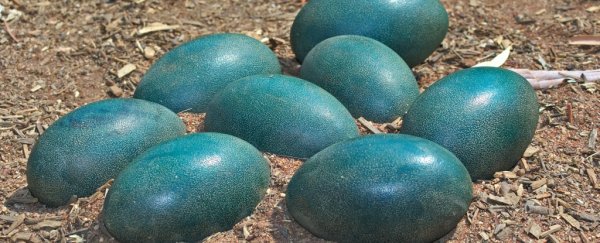A new study has revealed that at least one dinosaur species laid eggs that were a striking blue-green colour - and that suggests the creatures were even more like birds than we previously thought.
Analysis of a fossilised dinosaur nest has now confirmed the egg shells found within weren't discoloured by fossilisation, but were actually blue. And colour matters - in this case it hints at a nesting structure where devoted fathers watched the eggs.
The dinosaur in question is a species of Late Cretaceous oviraptor called Heyuannia huangi - a beaked ostrich-like dinosaur that lived 66 million years ago in China.
Many birds, and all reptiles, lay white, unpigmented eggs - and the assumption had long been that all dinosaurs did too.
"Once the idea that coloured eggs evolved in birds and were a trait of modern birds had been suggested, no one thought about it again or dared to ask if dinosaur eggs had been coloured," lead researcher Jasmina Wiemann of Yale University told National Geographic.
Fossilised dinosaur eggs are usually brown or black because minerals such as iron and iron oxide in the earth stain them during the fossilisation process. But Heyuannia's eggs have a blue tint not present in other eggs.
 PeerJ/Wiemen et al.
PeerJ/Wiemen et al.
Several modern birds have blue-tinted eggs. The robin is the most well-known, but starlings and house finches do as well. Some chickens and ducks lay pastel-coloured blue eggs.
And large paleognathae such as the ostrich, the emu and the cassowary, to which Heyuannia bears a resemblance, lay beautiful dark blue- and green-hued eggs.
In modern birds, blue and green eggs are caused by a pigment from the bird's bile called biliverdin. Another pigment, protoporphyrin, causes red and brown colouring, and speckles.
Using mass spectrometry to analyse the fossilised nest, the team found that both these pigments were present in Heyuannia's egg shells.
"We screened through lots of eggshells, and one day had a positive result for these oviraptor eggs. It was a huge surprise. I couldn't believe it," Wiemann told National Geographic.
Importantly, the discovery further strengthens the link between dinosaurs and birds, and offers clues as to Heyuannia's behaviour.
Today, the colour of cassowary, emu, and ostrich eggs helps camouflage them from predators in open ground nests. And those ground nests are watched over by the fathers of the species.
Because of this, the blue colouring of Heyuannia's eggs suggests that they had a similar nesting structure, including fathers that were very devoted to their nests.
This hypothesis can't be confirmed by fossil evidence alone, but it's a possibility that's previously been brought up after analysis of theropod nests. This latest discovery makes it a lot more likely that these ostrich-like dinosaurs were once great dads.
"Such a nest arrangement corresponds with our reconstruction of blue-green eggs for oviraptors," the team conclude in the journal PeerJ .
"According to the sexual signalling hypothesis, the reconstructed blue-green eggs support the origin of previously hypothesised avian paternal care in oviraptorid dinosaurs."
The research has been published in the journal PeerJ.
